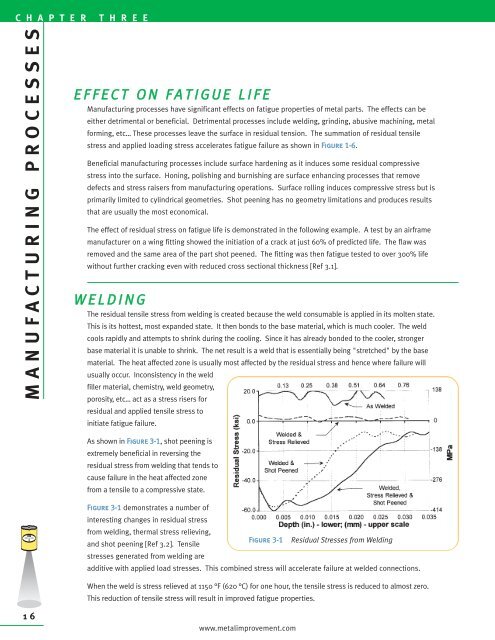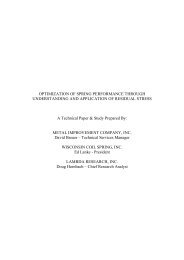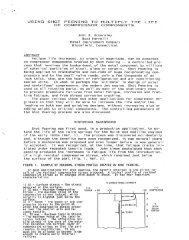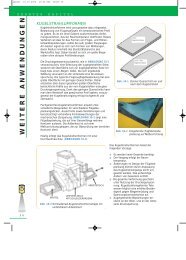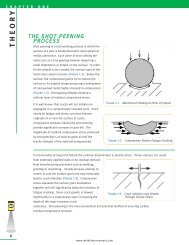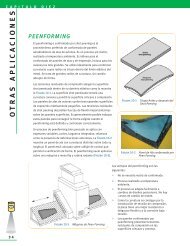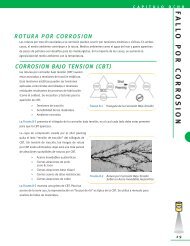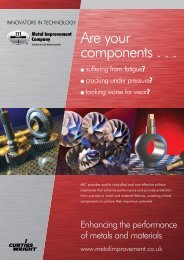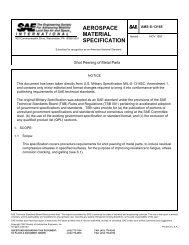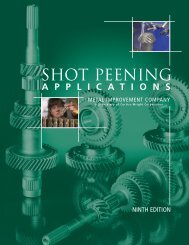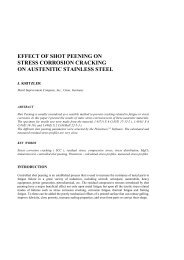shot peening residual stress - Metal Improvement Company
shot peening residual stress - Metal Improvement Company
shot peening residual stress - Metal Improvement Company
You also want an ePaper? Increase the reach of your titles
YUMPU automatically turns print PDFs into web optimized ePapers that Google loves.
C H A P T E R T H R E E<br />
MANUFA CTURING PROCESSES<br />
16<br />
E F F E C T O N F A T I G U E L I F E<br />
Manufacturing processes have significant effects on fatigue properties of metal parts. The effects can be<br />
either detrimental or beneficial. Detrimental processes include welding, grinding, abusive machining, metal<br />
forming, etc… These processes leave the surface in <strong>residual</strong> tension. The summation of <strong>residual</strong> tensile<br />
<strong>stress</strong> and applied loading <strong>stress</strong> accelerates fatigue failure as shown in Figure 1-6.<br />
Beneficial manufacturing processes include surface hardening as it induces some <strong>residual</strong> compressive<br />
<strong>stress</strong> into the surface. Honing, polishing and burnishing are surface enhancing processes that remove<br />
defects and <strong>stress</strong> raisers from manufacturing operations. Surface rolling induces compressive <strong>stress</strong> but is<br />
primarily limited to cylindrical geometries. Shot <strong>peening</strong> has no geometry limitations and produces results<br />
that are usually the most economical.<br />
The effect of <strong>residual</strong> <strong>stress</strong> on fatigue life is demonstrated in the following example. A test by an airframe<br />
manufacturer on a wing fitting showed the initiation of a crack at just 60% of predicted life. The flaw was<br />
removed and the same area of the part <strong>shot</strong> peened. The fitting was then fatigue tested to over 300% life<br />
without further cracking even with reduced cross sectional thickness [Ref 3.1].<br />
W E L D I N G<br />
The <strong>residual</strong> tensile <strong>stress</strong> from welding is created because the weld consumable is applied in its molten state.<br />
This is its hottest, most expanded state. It then bonds to the base material, which is much cooler. The weld<br />
cools rapidly and attempts to shrink during the cooling. Since it has already bonded to the cooler, stronger<br />
base material it is unable to shrink. The net result is a weld that is essentially being "stretched" by the base<br />
material. The heat affected zone is usually most affected by the <strong>residual</strong> <strong>stress</strong> and hence where failure will<br />
usually occur. Inconsistency in the weld<br />
filler material, chemistry, weld geometry,<br />
porosity, etc… act as a <strong>stress</strong> risers for<br />
<strong>residual</strong> and applied tensile <strong>stress</strong> to<br />
initiate fatigue failure.<br />
As shown in Figure 3-1, <strong>shot</strong> <strong>peening</strong> is<br />
extremely beneficial in reversing the<br />
<strong>residual</strong> <strong>stress</strong> from welding that tends to<br />
cause failure in the heat affected zone<br />
from a tensile to a compressive state.<br />
Figure 3-1 demonstrates a number of<br />
interesting changes in <strong>residual</strong> <strong>stress</strong><br />
from welding, thermal <strong>stress</strong> relieving,<br />
and <strong>shot</strong> <strong>peening</strong> [Ref 3.2]. Tensile<br />
<strong>stress</strong>es generated from welding are<br />
Figure 3-1 Residual Stresses from Welding<br />
additive with applied load <strong>stress</strong>es. This combined <strong>stress</strong> will accelerate failure at welded connections.<br />
When the weld is <strong>stress</strong> relieved at 1150 °F (620 °C) for one hour, the tensile <strong>stress</strong> is reduced to almost zero.<br />
This reduction of tensile <strong>stress</strong> will result in improved fatigue properties.<br />
www.metalimprovement.com


